Engine PONTIAC GRAND PRIX 1998 Repair Manual
[x] Cancel search | Manufacturer: PONTIAC, Model Year: 1998, Model line: GRAND PRIX, Model: PONTIAC GRAND PRIX 1998Pages: 402, PDF Size: 17.96 MB
Page 243 of 402
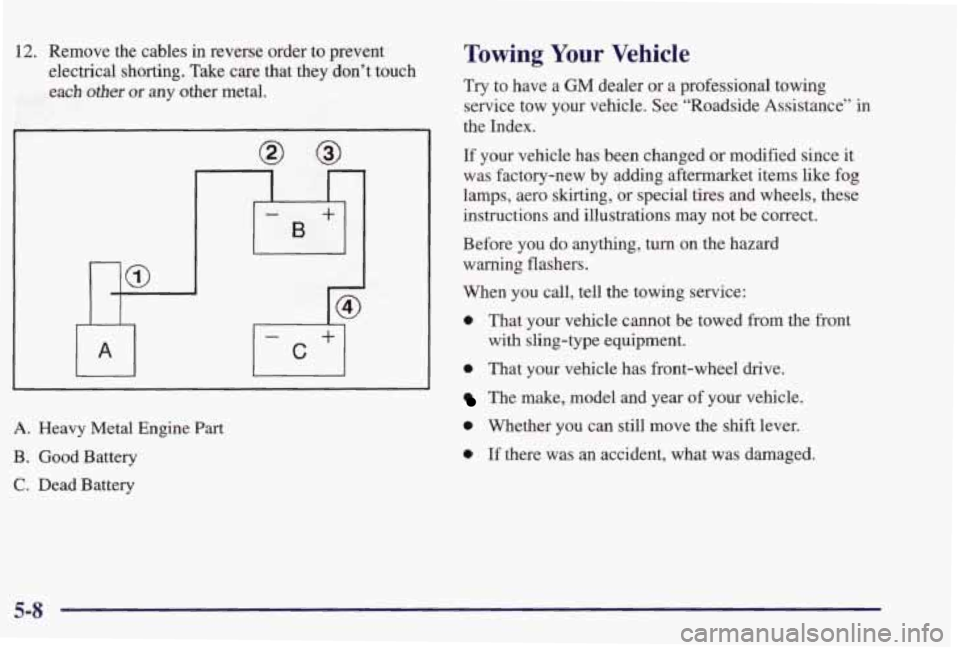
12. Remove the cables in reverse order to prevent
electrical shorting. Take care that they don’t touch
each
other or any other metal.
nlo I
A. Heavy Metal Engine Part
B. Good Battery
C. Dead Battery
Towing Your Vehicle
Try to have a GM dealer or a professional towing
service tow your vehicle.
See “Roadside Assistance” in
the Index.
If your vehicle has been changed or modified since it
was factory-new by adding aftermarket items like fog
lamps, aero skirting,
or special tires and wheels, these
instructions and illustrations may not be correct.
Before you do anything, turn on the hazard
warning flashers.
When you call, tell the towing service:
0 That your vehicle cannot be towed from the front
0 That your vehicle has front-wheel drive.
The make, model and year of your vehicle.
0 Whether you can still move the shift lever.
0 If there was an accident, what was damaged.
with sling-type equipment.
5-8
Page 250 of 402
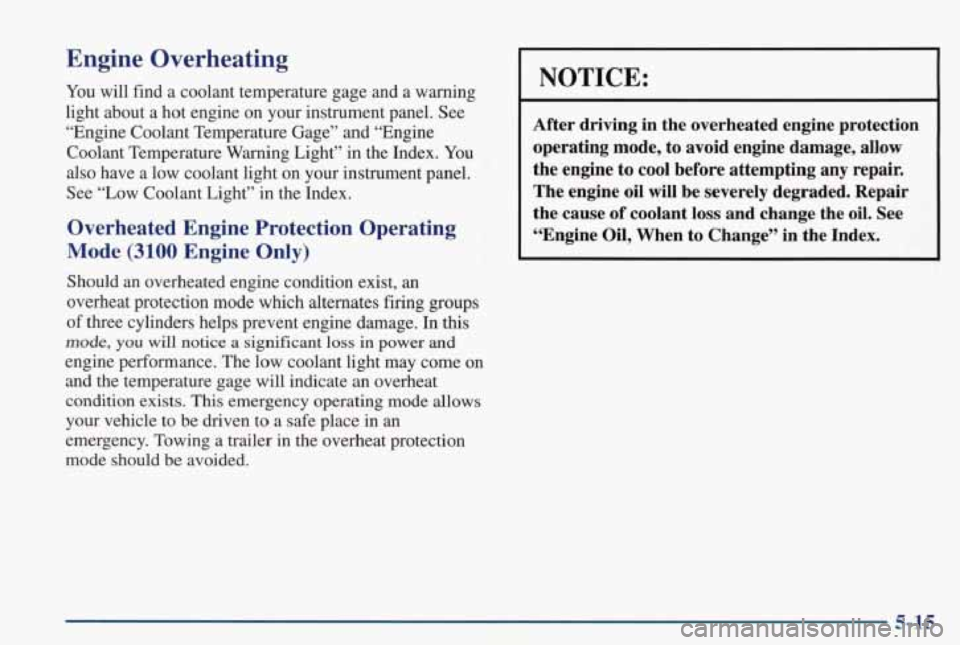
Engine Overheating
You will find a coolant temperature gage and a warning
light about a hot engine on your instrument panel. See
“Engine Coolant Temperature Gage” and “Engine
Coolant Temperature Warning Light” in the Index. You
also have a low coolant light on your instrument panel.
See “Low Coolant Light” in the Index.
Overheated Engine Protection Operating
Mode
(3100 Engine Only)
Should an overheated engine condition exist, an
overheat protection mode which alternates firing groups
of three cylinders helps prevent engine damage. In this
mode, you will notice a significant loss in power and
engine performance. The low coolant light may come on
and the temperature gage will indicate an overheat
condition exists. This emergency operating mode allows
your vehicle to be driven to a safe place in an
emergency. Towing a trailer in the overheat protection
mode should
be avoided.
NOTICE:
After driving in the overheated engine protection
operating mode, to avoid engine damage,
allow
the engine to cool before attempting any repair.
The engine
oil will be severely degraded. Repair
the cause of coolant loss and change the oil. See
“Engine Oil, When to Change” in the Index.
5-15
Page 251 of 402

If Steam Is Coming From Your Engine
A CAUTION:
-
Steam from an overheated engine can burn you
badly, even if you just open the hood. Stay away
from the engine
if you see or hear steam coming
from
it. Just turn it off and get everyone away
from the vehicle until it cools down. Wait until
there
is no sign of steam or coolant before you
open the hood.
If you keep driving when your engine is
overheated, the liquids in
it can catch fire. You or
others could be badly burned. Stop your engine if
it overheats, and get out of the vehicle until the
engine is cool.
5-16
Page 252 of 402

NOTICE:
If your engine catches fire because you keep
driving with no coolant, your vehicle can be
badly damaged. The costly repairs would not be
covered by your warranty.
If your vehicle has the
3100 engine, see “Overheated Engine Protection
Operating Mode” in the Index.
If No Steam Is Coming From Your Engine
If you get the overheat warning but see or hear no
steam, the problem may not be too serious. Sometimes
the engine can get a little too hot when you:
Climb a long hill on a hot day.
Stop after high-speed driving.
Idle for long periods in traffic.
Tow a trailer.
If you get the overheat warning with no sign of steam,
try this for a minute or so:
1. Turn off your air conditioner.
2. Turn on your heater to full hot at the highest fan
speed and open the window as necessary.
3. If you’re in a traffic jam, shift to NEUTRAL (N);
otherwise, shift to the highest gear while
driving
-- AUTOMATIC OVERDRIVE (03)
or DRIVE (D).
If you no longer have the overheat warning, you
can
drive. Just to be safe, drive slower for about
10 minutes. If the warning doesn’t come back on,
you can
drive normally.
If the warning continues, pull over, stop, and park
your
vehicle right away.
If there’s still no sign of steam, you can idle the engine
for two or three minutes while you’re parked, to see if
the warning stops. But then, if you still have the
warning,
turn off the engine and get everyone out of
the vehicle until it cools down. If your vehicle has the
3 100 engine, see “Overheated Engine Protection
Operating Mode” listed previously in this section.
You may decide not to lift the hood but to get service
help right away.
5-17
Page 253 of 402
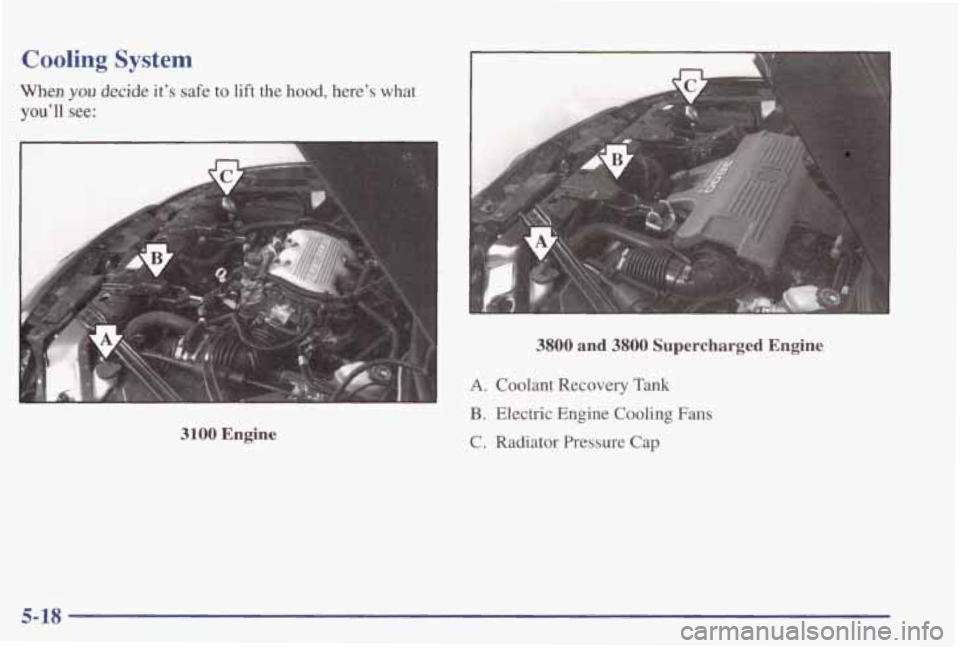
Cooling System
When you decide it’s safe to lift the hood, here’s what
you’ll see:
3100 Engine
3800 and 3800 Supercharged Engine
A. Coolant Recovery Tank
B. Electric Engine Cooling Fans
C. Radiator Pressure Cap
5-18
Page 254 of 402
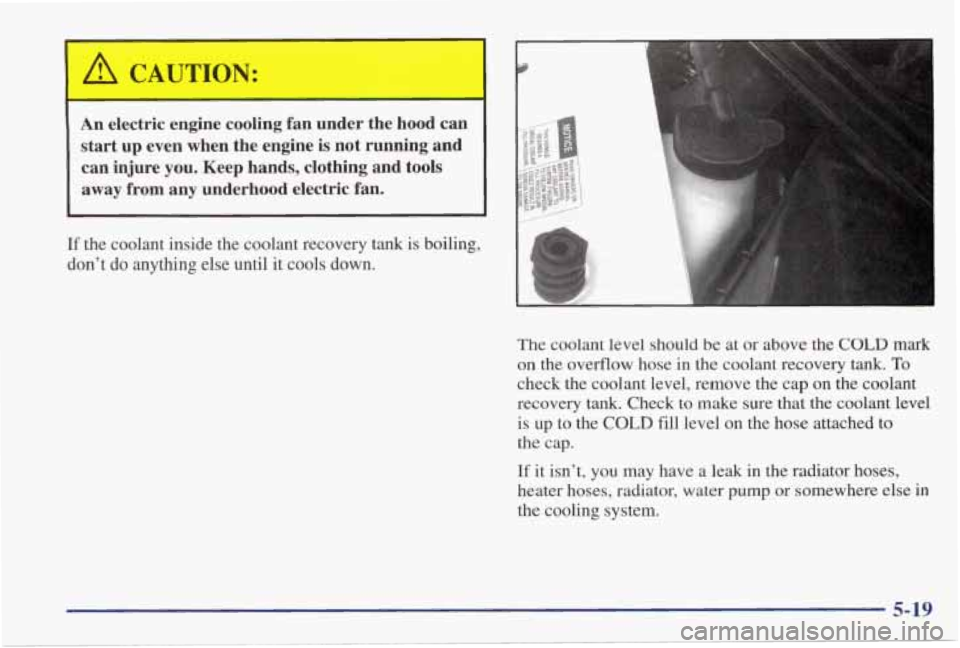
’ A CAUTION:
An electric engine cooling fan under the hood can
start up even when the engine is not running and
can injure you. Keep hands, clothing and tools
away
from any underhood electric fan.
If the coolant inside the coolant recovery tank is boiling,
don’t do anything else until it
cools down.
The coolant level should be at or above the COLD mark
on the overflow hose
in the coolant recovery tank. To
check the coolant level, remove the cap on the coolant
recovery tank. Check to make sure that the coolant level
is up to the COLD fill level on the hose attached to
the cap.
If it isn’t,
you may have a leak in the radiator hoses,
heater hoses, radiator, water pump or somewhere else in
the cooling system.
5-19
Page 255 of 402
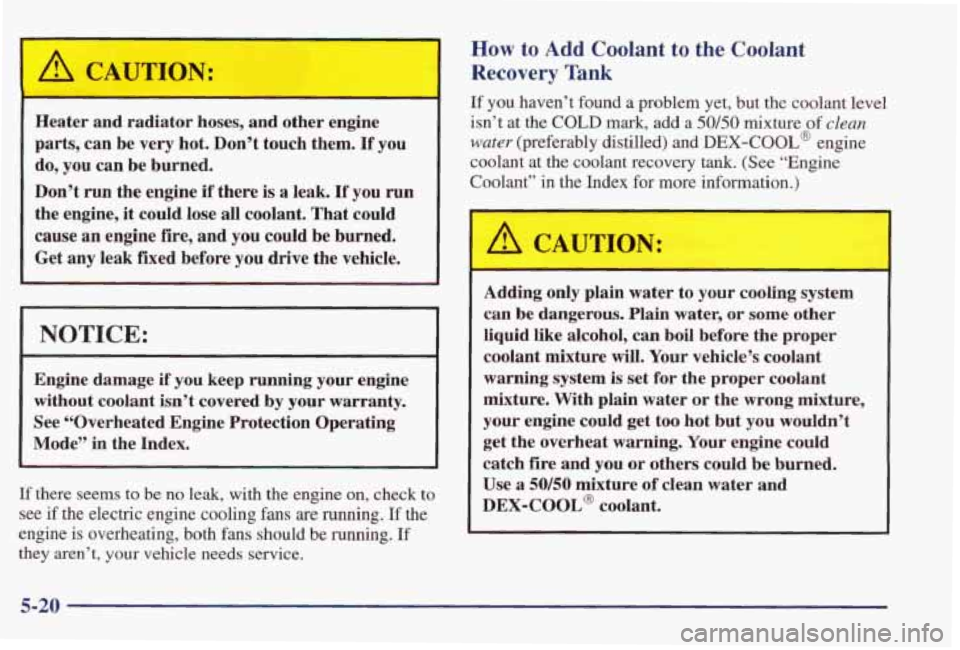
I A CAUTION: I
Heater and radiator hoses, and other engine
parts, can be very hot. Don’t touch them.
If you
do, you can be burned.
Don’t run the engine
if there is a leak. If you run
the engine, it could lose all coolant. That could
cause
an engine fire, and you could be burned.
Get any leak fined before you drive the vehicle.
NOTICE:
Engine damage if you keep running your engine
without coolant isn’t covered by your warranty.
See “Overheated Engine Protection Operating
Mode” in the Index.
If there seems to be no leak, with the engine
on, check to
see if the electric engine cooling fans are running. If the
engine is overheating,
both fans should be running. If
they aren’t, your vehicle needs service.
How to Add Coolant to the Coolant
Recovery Tank
If you haven’t found a problem yet, but the coolant level
isn’t at the
COLD mark, add a 50/50 mixture of clean
wuter (preferably distilled) and DEX-COOL@ engine
coolant at the coolant recovery tank. (See “Engine
Coolant”
in the Index for more information.)
Adding only
plain water to your cooling system
can
be dangerous. Plain water, or some other
liquid like alcohol, can boil before the proper
coolant mixture
will. Your vehicle’s coolant
warning system
is set for the proper coolant
mixture. With plain
water or the wrong mixture,
your engine could get too hot but you wouldn’t
get the overheat warning. Your engine could
catch fire and you or others could
be burned.
Use
a 50/50 mixture of clean water and
DEX-COOL@ coolant.
5-20
Page 256 of 402
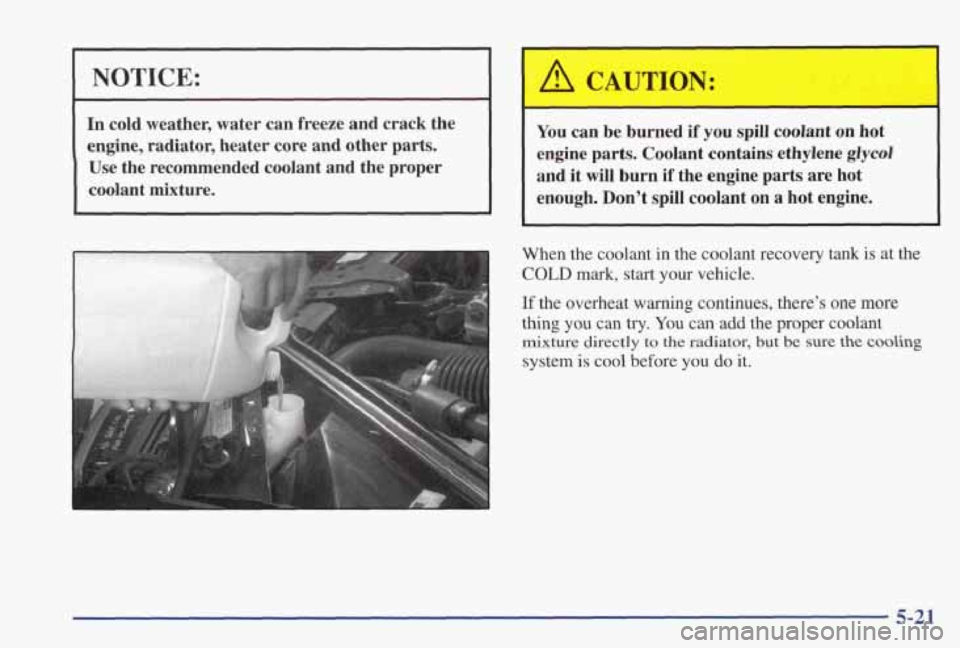
I NOTICE:
In cold weather, water can freeze and crack the
engine, radiator, heater core and other parts.
Use the recommended coolant and the proper
coolant mixture. You
can be burned if you spill coolant on hot
engine parts. Coolant contains ethylene
glycol
and it will burn if the engine parts are hot
enough. Don’t spill coolant
on a hot engine.
When the coolant
in the coolant recovery tank is at the
COLD mark, start your vehicle.
If the overheat warning continues, there’s one more
thing you can try. You can add the proper coolant
mixture directly to the radiator, but be sure the cooling
system is cool before you do it.
5-21
Page 257 of 402
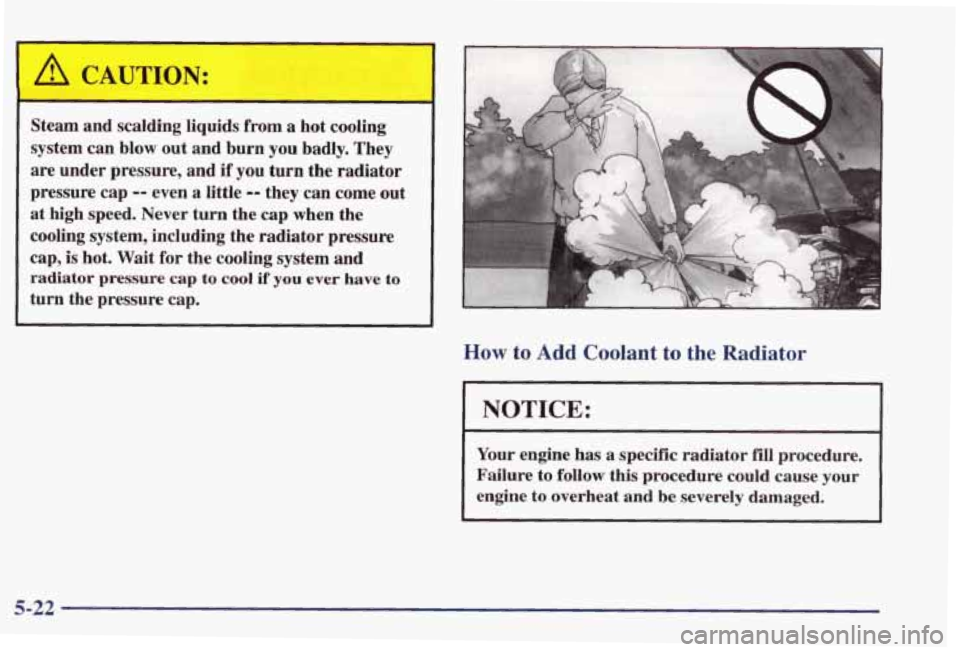
Steam and scalding liquids from a hot cooling
system can blow out and burn you badly. They
are under pressure, and if you turn the radiator
pressure cap
-- even a little -- they can come out
at
high speed. Never turn the cap when the
cooling system, including the radiator pressure
cap, is hot. Wait for the cooling system and
radiator pressure cap to cool if you ever have to
turn the pressure cap.
How to Add Coolant to the Radiator
NOTICE:
Your engine has a specific radiator fill procedure.
Failure to
follow this procedure could cause your
engine to overheat and be severely damaged.
5-22
Page 258 of 402
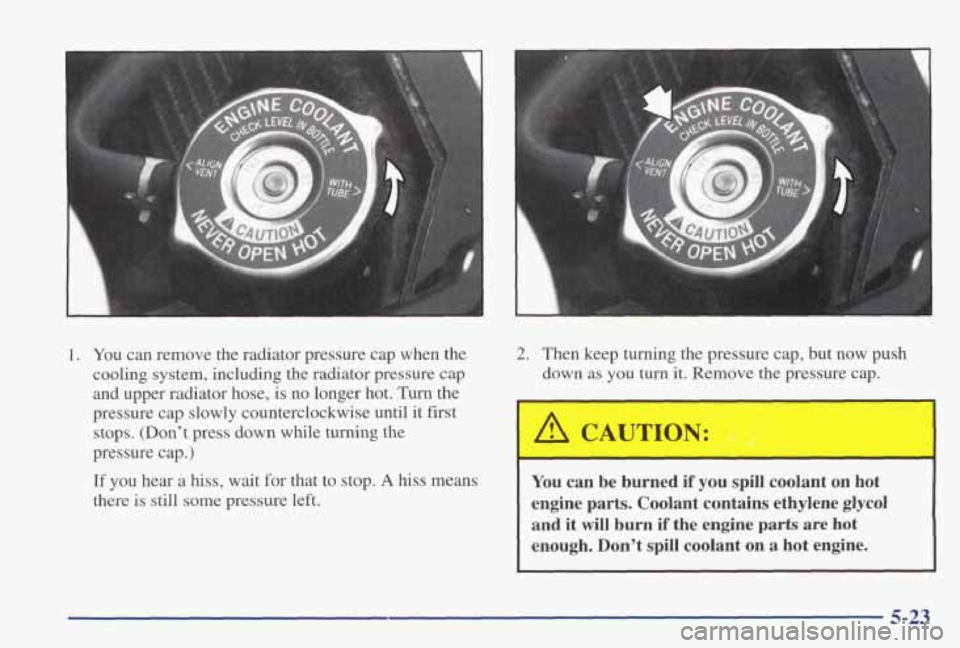
1. You can remove the radiator pressure cap when the
cooling system, including the radiator pressure cap
and upper radiator hose,
is no longer hot. Turn the
pressure cap slowly counterclockwise until
it fist
stops. (Don't press
down while turning the
pressure cap.)
If you hear a hiss, wait for that to stop. A hiss means
there
is still some pressure left.
2. Then keep turning the pressure cap, but now push
down
as you turn it. Remove the pressure cap.
You can be burned if you spill coolant on hot
engine parts. Coolant contains ethylene glycol
and it will burn if the engine parts are hot
enough. Don't spill coolant on
a hot engine.
5-23